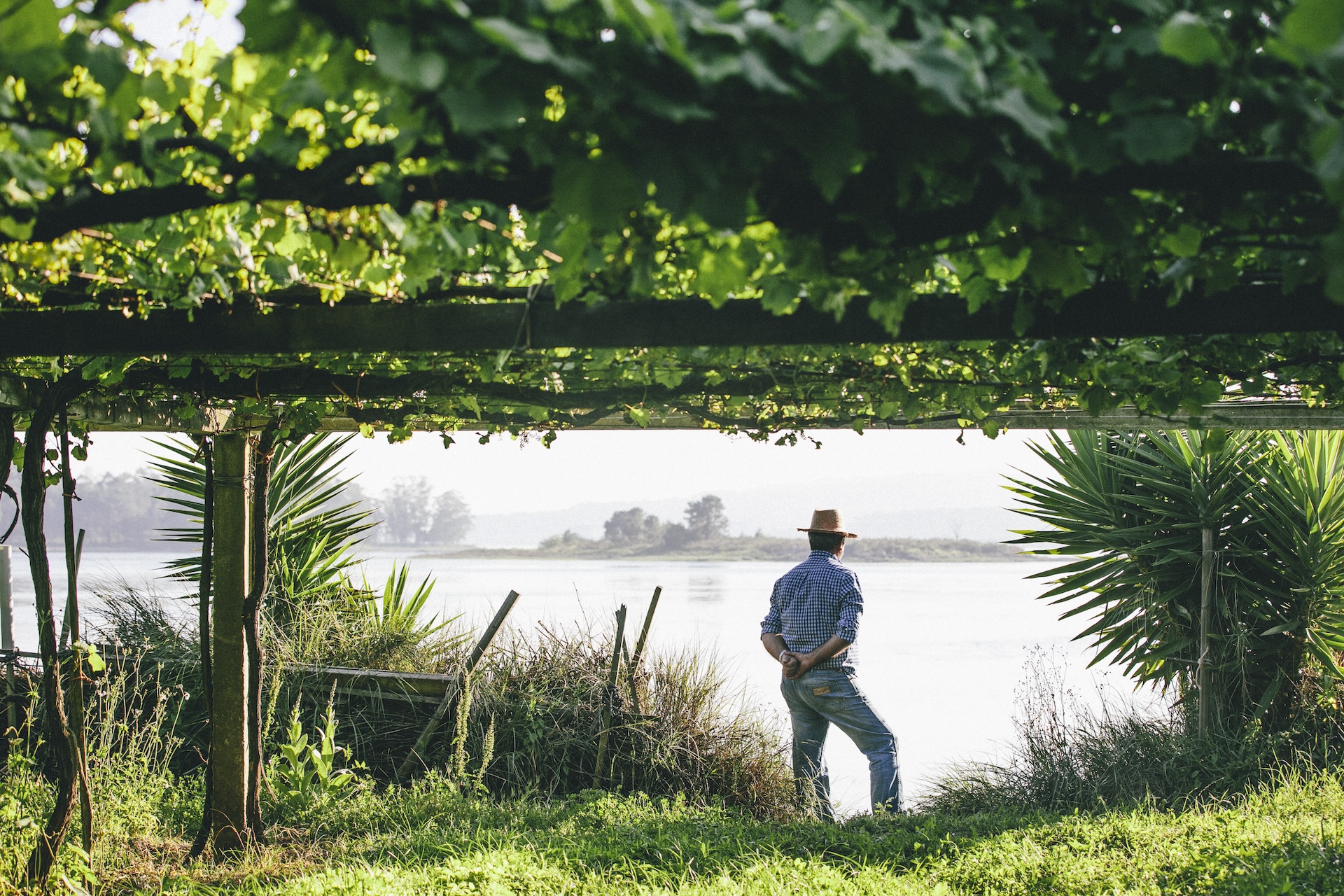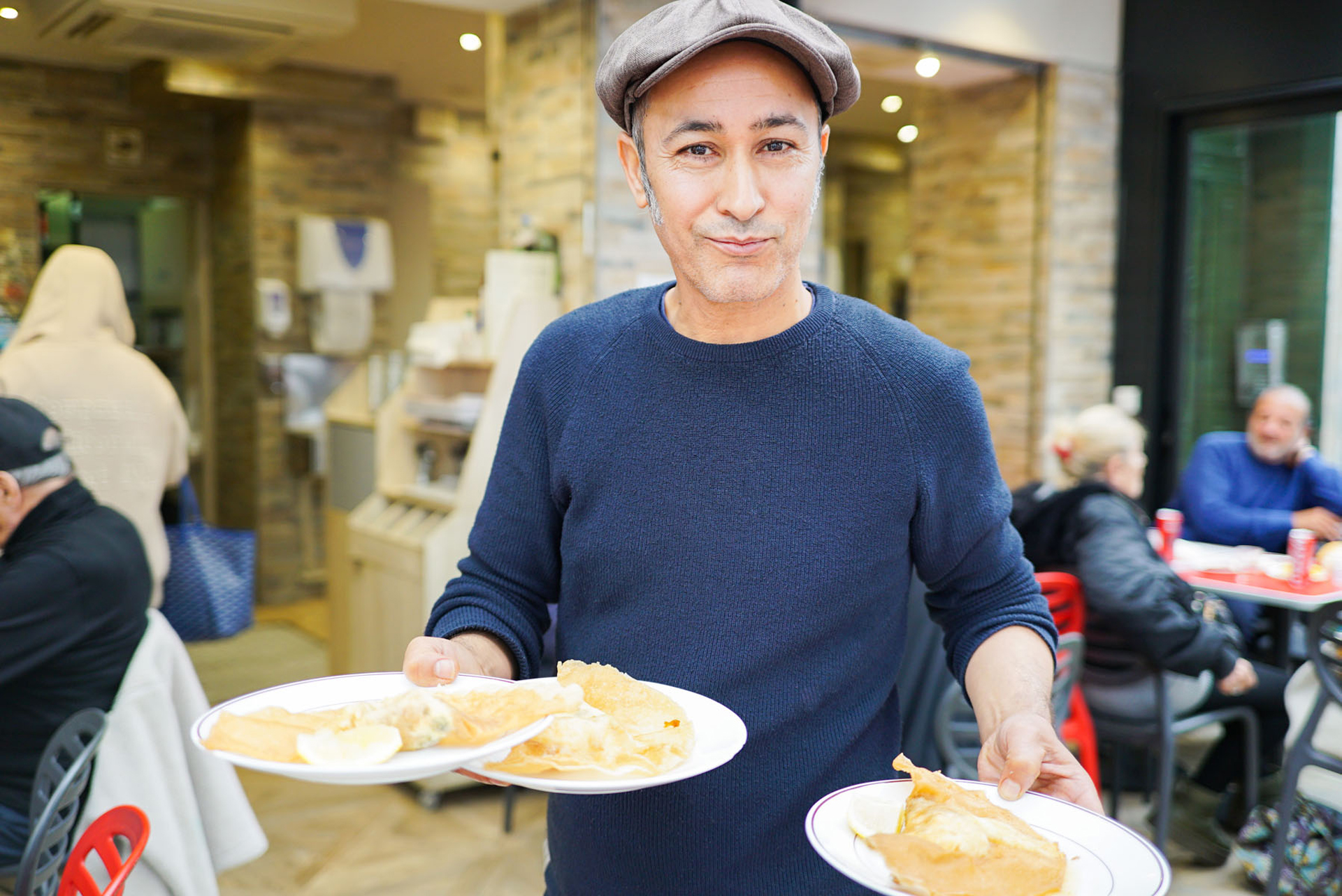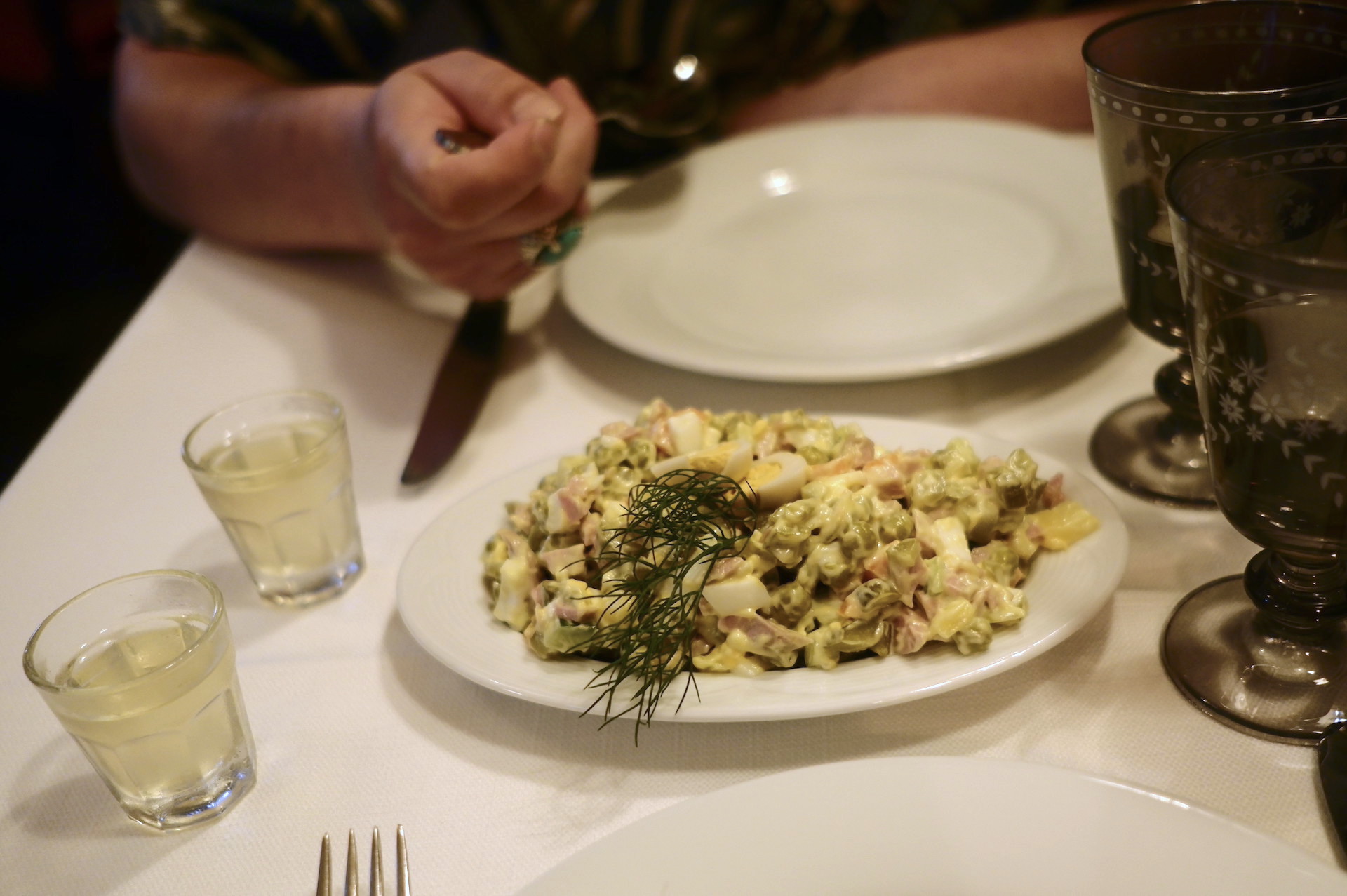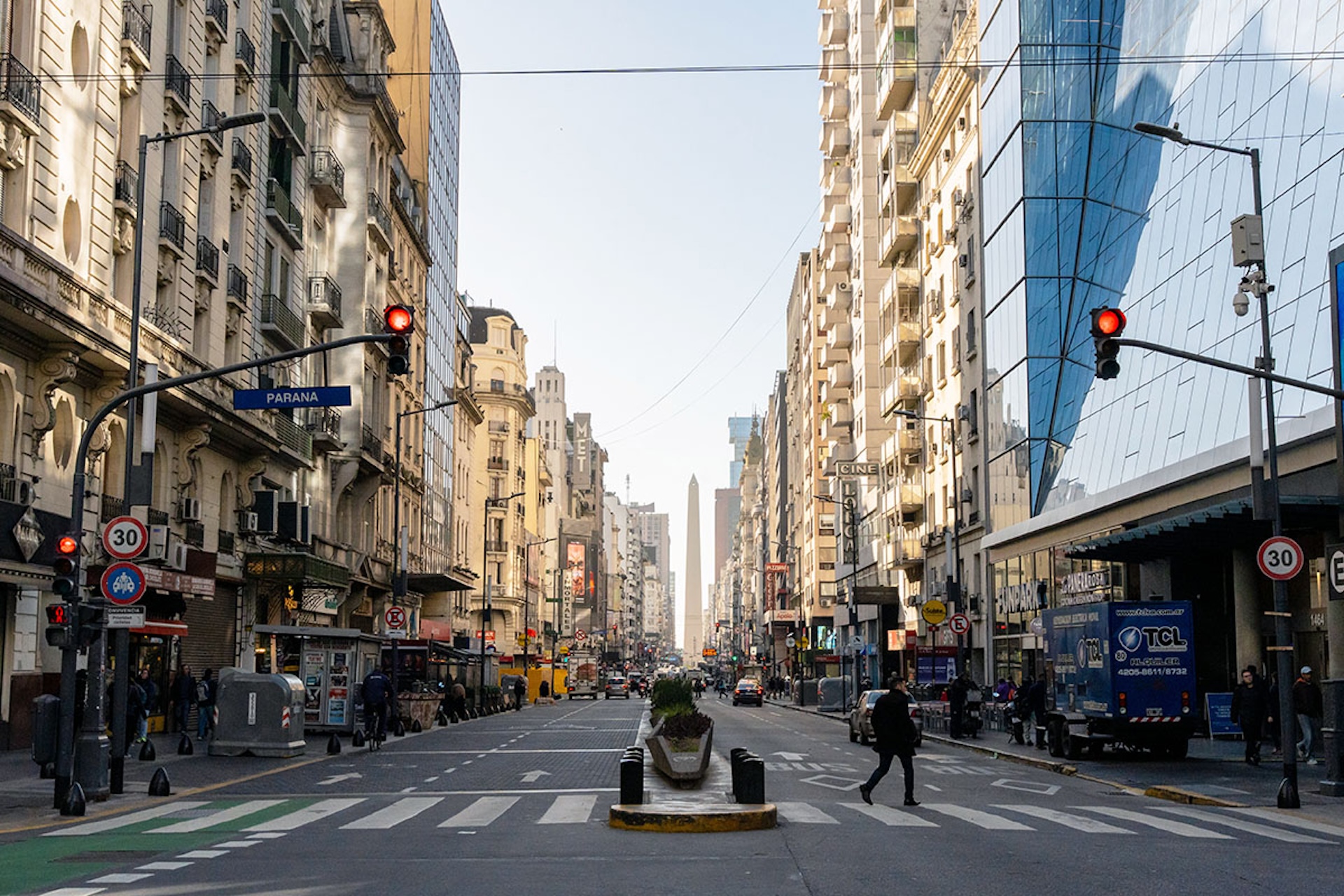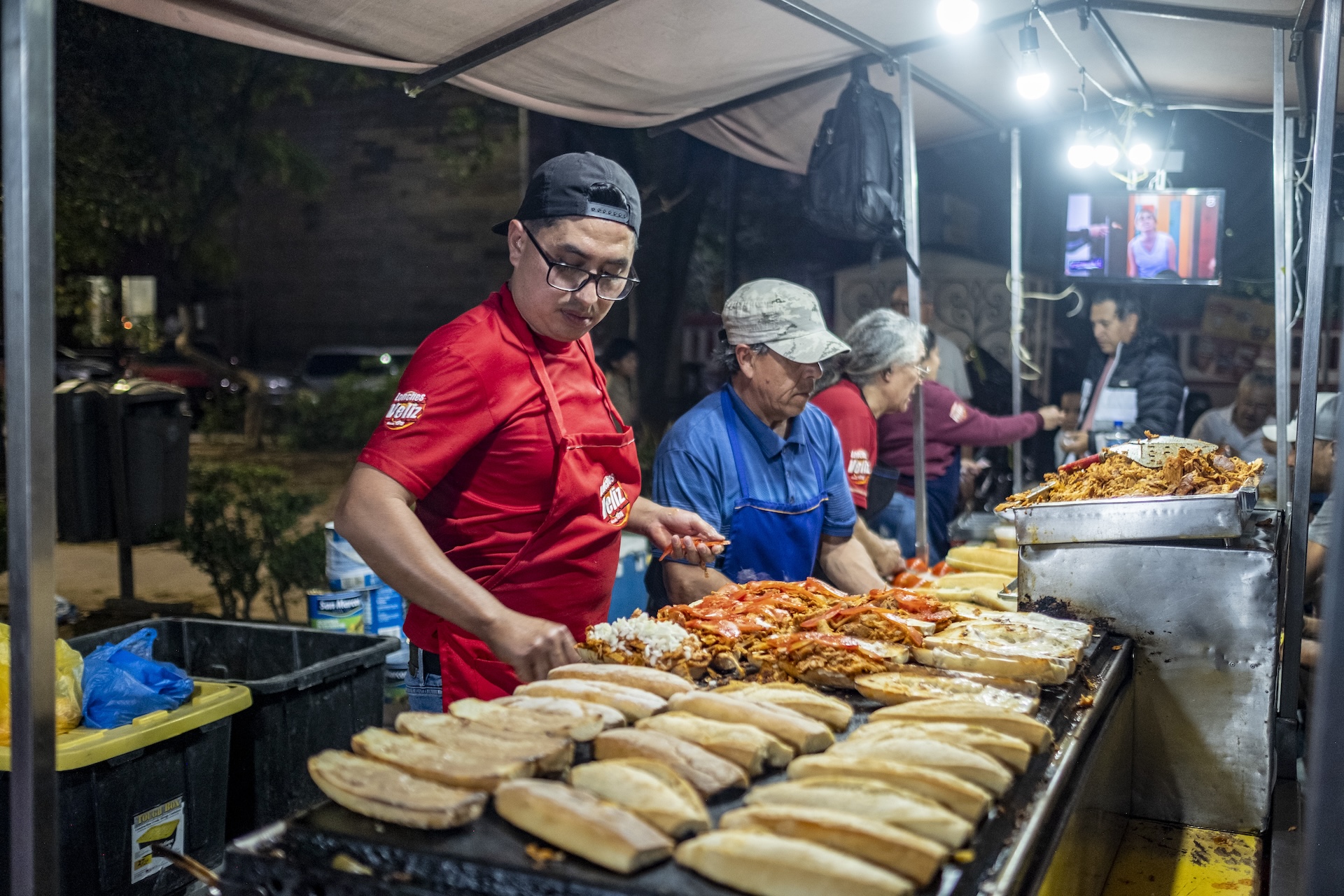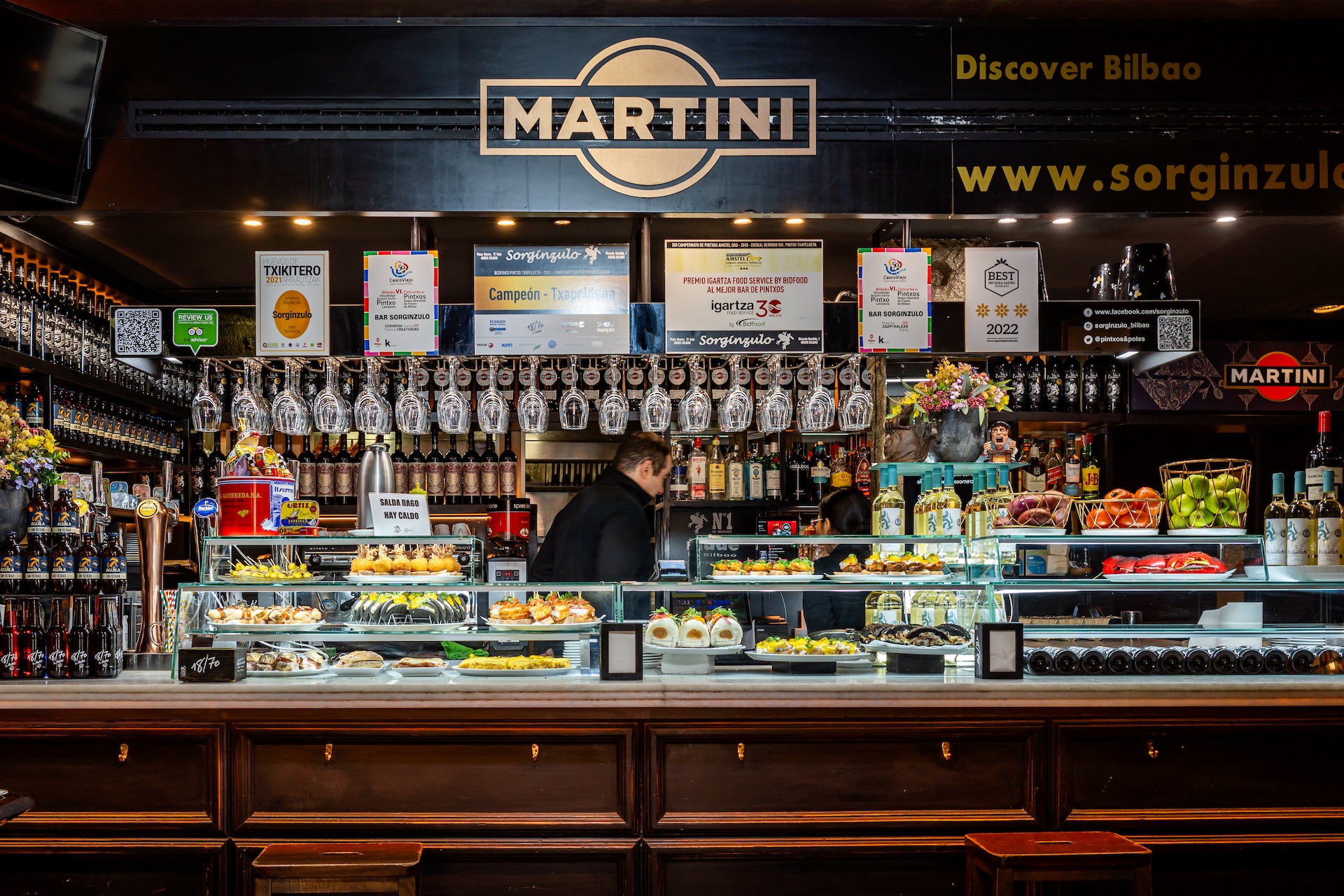We can't find the internet
Attempting to reconnect
Something went wrong!
Hang in there while we get back on track
Search results for word=paul+r
Lisbon
Essential Services: In Lisbon, A New Farmers’ Market on the Block
The current Praça de São Paulo formed in the wake of a disaster: the square was rebuilt soon after the 1755 Lisbon earthquake, and serves as a model of the architectural style from that time. More recently, this beautiful yet oft-neglected square has been given a new lease on life thanks to another calamity – the Covid-19 pandemic. Over the summer, chef André Magalhães took over the square’s charming red kiosk – the oldest in Lisbon – and overhauled the menu, filling it with traditional drinks, delicious sandwiches and petiscos. And since the start of November, the grocery store Comida Independente has been organizing a successful farmers’ market in the square on Saturdays, bringing Lisboetas in contact with independent producers and one another – a balm in this strange time of social distancing.
Read moreBarcelona
Panellets for All Saints' Day: For Whom the Bell Sweetly Tolls
While Americans celebrate Halloween this week with M&Ms and Milk Duds, in Catalonia this time of the year is marked with a different, more sophisticated, kind of sweet. The small, round marzipan cookies called panellets are, along with roasted chestnuts and sweet wine, the traditional fare of All Saints’ Day, or Tots Sants in Catalan.
Read moreParis
Paris, State of the Stomach: Is the French capital the world’s most exciting food city?
Paris dining moves between nostalgia and reinvention. From bistros reborn as PMU-style bars to chefs blending Sri Lankan spice with French technique, the city’s appetite for both comfort and change keeps it the most exciting food capital on Earth.
Read moreTbilisi
Tbilisi’s Best Wine Bars
Georgia’s astounding winemaking tradition traces back eight millennia, and is not to be missed. From the country’s different varieties, terroirs, and winemaking methods, there’s a lot to learn – and taste – when it comes to Georgian wine. As a starting point (or simply for those who don’t have time to venture out of the city), Tbilisi’s wine bars are a great place to have a glass or two and dig into Georgian viticulture. Wine bars are a relatively new trend in Georgia and about the greatest thing to happen since the invention of the kvevri, the characteristic ceramic vessels for fermenting and storing traditional Georgian wine.
Read moreLisbon
Juliana Penteado Pastry: Baking Lisbon a Better Place
It’s been a long journey – literally – for pastry chef Juliana Penteado, culminating in her small-but-beautiful bakery in Lisbon’s São Bento neighborhood, and another shop soon to come. The Brazilian chef first enrolled in a cooking school in São Paulo at age 12 where, she would spend six years studying. As a young girl, she went back and forth between cooking and baking, but the latter would eventually win. “I also like cooking but baking has a more delicate and feminine side which make my eyes sparkle,” she tells us. It’s that inspiration which shines through in the elegant, lovingly made pastries that have become her calling card.
Read moreIstanbul
Ayaspaşa Russian Restaurant : Istanbul's Cosmopolitan Past in the Present
Boris Ivanovitch, a White Russian refugee who was among the more than 100,000 who fled the Bolshevik Revolution to Constantinople, and Judith Kreschanovsky, an immigrant from Hungary, set the trajectory of the menu when they first set a table at Ayaspaşa for the public. Such a restaurant only ever could have opened in the early years of Republican Istanbul, where people who might have never otherwise met anywhere else on earth crossed paths in “The City.” The menu was and is composed of recipes that Judith cooked herself, and features elements of Russian and Hungarian cuisine.
Read moreBarcelona
Mercat de Sant Antoni: The Market’s Back in Town
“I still don’t know where the siphon bottles for the vermut are,” says an employee of Marina, a small bar in the newly renovated Mercat de Sant Antoni. It’s clear as we’re walking around that the staff of the market’s few bars and its many vendors are still settling in and adapting to their brand new spots. At the same time, hundreds of visitors have been exploring the revamped market each day since its opening last week asking, “Where can we eat or drink something?” So far, that seems to be the question on everyone’s mind, particularly locals. But this is not another food hall, this is a proper neighborhood market focused on selling quality fresh produce and other food product
Read moreBarcelona
Buriti: Brazil Comes to Barcelona
The buriti, which grows in wet riversides and swamps, is among the most splendid of South American palms. This tree has special significance in Brazil: it is even an unsuspecting main character in the Brazilian epic novel The Devil to Pay in The Backlands, written by João Guimarães Rosa. For the Guaraní, an indigenous group of the southwest of the country, the buriti palm is a generous being from which each element can be used: fruit, bark, leaves, oil – it’s why its name means “Tree of Life.” Now, a new Buriti has flourished in Barcelona, just a stone’s throw from the shore in the beachside Poble Nou neighborhood. A Brazilian restaurant full of nostalgic flavors prepared with great skill and served in portions to share tapas-style, but with an authentic Brazilian taste.
Read moreBarcelona
Mamá Heladera: Gelato, Flavored By Memories
The smell of clean clothes with a lavender sachet from grandma’s closet; the family farm in nearby Lleida province during summer with apple trees and wild aromatic herbs growing all around; peaches washed in seawater during a beach day; an afternoon snack of popsicles while playing under the pine tree in the garden. These are just some of the memories that neighbors left in the mailbox of Mamá Heladera in Barcelona’s Poblenou, where owner Irene Iborra turns them into gelato flavors – an initiative that was recently awarded by the Barcelona City Council as best new innovative business (XVII Premis Barcelona Comerç). Mamá Heladera sits next to Tío Che, a classic horchateria and ice-cream parlor on Rambla del Poblenou that opened in 1912.
Read moreTokyo
First Stop: Brendan Liew’s Tokyo
Editor’s note: In the latest installment of our recurring First Stop feature, we asked chef and author Brendan Liew about some of his favorite spots to eat in Tokyo. A chef by training, Brendan Liew has worked at restaurants including three-Michelin-starred Nihonryori Ryugin in Tokyo and Hong Kong and Sushi Minamishima in Melbourne. He’s currently at Warabi, a Japanese kappo omakase in Melbourne. He has also authored three books on Japanese cuisine: A Day In Tokyo, Tokyo Up Late and Konbini. You can follow Brendan on Instagram here.
Read morePorto
On the Road: Feasting on Suckling Pig and Sparkling Wine in Bairrada
At first glance, there’s not much to see in Mealhada, a town in Portugal’s central inland Bairrada region about an hour’s drive south of Porto. If there is a main feature here, it’s probably the EN1, the country’s original north-south highway, which slices the town in half, providing a conduit for a seemingly never-ending parade of large, noisy trucks. Yet the town’s roadside signs reveal something else: “Rei dos Leitões,” “Pedro dos Leitões,” “Virgílio dos Leitões,” “Meta dos Leitões,” “Hilário Leitão.” Mealhada is ground zero in Portugal for leitão, roast suckling pig.
Read moreIstanbul
Mezme: Masters of Meze
When Mezme, an excellent meze deli and meyhane tucked away on a tiny backstreet in the corner of Istanbul’s multicultural Kurtuluş neighborhood, first opened in 2020, it quickly became one of our go-to spots. Our hearts sank when the restaurant closed in early 2024, but we were delighted to find it recently reopened and charmingly renovated, with the friendly owner, chef, and lifelong Kurtuluş resident Sasun Estukyan back in his place helming the kitchen. Prior to opening Mezme, Sasun worked for five years as a cook at a retirement home in Harbiye, a nearby neighborhood. But he says he felt a call to start making the mezes that he grew up eating and helping prepare, staples of his aunt and mother's kitchens. These dishes blend classic Istanbul cuisine with that of the southern province of Hatay, from which his mother's side of the family hails.
Read moreIstanbul
Kavurmacı Goze: Slow-Cooked in Sirkeci
Right in the heart of Istanbul's historic Sirkeci quarter are an equal number of tourist traps and gems. At the former, overly eager employees shove menus in your face and pressure you to sit down for an average, overpriced döner kebab on a crowded corner. The latter are the exact opposite; tucked away on ground floors in unlikely alleys, hidden in plain view. Just beneath the looming Deutsche Orientbank – a masterwork built over a century ago and crowned with a copper dome that long ago took on a turquoise hue – is Kavurmacı Goze, a small, elegantly designed restaurant with only one thing on the menu: kavurma (braised beef).
Read moreRio
Tacacá do Norte: The Amazonian Shake Shack
The eyes of Tacacá do Norte’s harried staff widen as yet another customer arrives during the lunchtime rush. The bedroom-sized snack bar can barely hold one line of chairs around its bar but they have somehow managed to squeeze in two. Impatient regulars shake hands and whistle “psst” to the young men staffing the establishment, who gingerly hand steaming pots of shrimp soup and freshly puréed juices over the packed bar.
Read moreRio
Rio de Janeiro: State of the Stomach
A grill of sizzling coração de galinha (chicken hearts), linguiça (sausage) and churrasco (steak) exudes a plume of smoke that sets the perfect theatrical stage as a woman in a red apron swings from side to side, dancing to Brazilian funk. The meat smells delicious, too. Maybe just one espetinho (skewer) before we go… Sundays at Feira da Glória market in Rio de Janeiro are an all-out assault on the senses – and on shoppers’ willpower. The sight of fruit stacked high on tables is almost as vibrant as Rio itself.
Read moreIstanbul
Bayramoğlu: Döner Domination
It's just shy of 4 p.m. on a gray Sunday afternoon in Istanbul, and there is a line out the door at Bayramoğlu, considered by many to be the best döner restaurant in Turkey. A sign on the corner of the building proudly proclaims the establishment to be the “pioneer of döner” and in the middle of the roof there is a human-sized model of a rotating döner, just in case it wasn't clear what the star of the show is around here. Inside are two huge dining rooms, hundreds of guests, and dozens of employees, who are running a tight ship across a sea of controlled chaos. There is nothing subtle about Bayramoğlu. This place is a juggernaut, spread across 1,000 square meters with four hulking döners cooking with the flames of high-quality oak charcoal, and two tandoori ovens (also wood-burning) where slices of fresh tandır ekmeği flatbread are cooked in seconds. When a guest leaves, their table is swiftly cleaned, and the next diner in line is quickly escorted in and their order taken: a single portion, one and a half, or a double?
Read moreGuadalajara
Guadalajara: The State of the Stomach
In Guadalajara, every sidewalk, corner, garage, vacant lot, food cart, car wash, and even bicycle has the potential to become a food stand – a restaurant just waiting to happen. But what truly sets our city's gastronomy apart is its contradictions. It’s both stubborn and traditional, yet constantly evolving. It belongs to no one, and everyone. It’s both sacred and profane because, while we take our recipes seriously, we’re not afraid to push boundaries and bring them to unexpected places. Case in point: “birriamen” – a mashup of the very local dish birria with Japanese import ramen.
Read moreMexico City
Boca del Río: Urban Seafood Oasis
In a city where dozens of new restaurants seem to sprout every week, it’s not an easy feat to stay on the culinary map for more than eight decades. Yet amidst the bustling streets of San Rafael hides a true oasis – a place where time seems to have stopped – a laid-back, family-run institution where fresh seafood and friendly service have been the norm for the past 80 years. Sitting down to lunch at Boca del Río on a Sunday is, perhaps, one of the best decisions we’ve made lately. The spacious, retro dining room is populated with a healthy mix of families, couples, and a few groups of friends who, like us, know their first mission is to order the ultimate Mexican hangover cure: micheladas and seafood. Afterwards comes a soothing cup of shrimp broth, savory and slightly spicy, keeping us company as we browse the menu.
Read moreIstanbul
Feeding People Amid Protests: Istanbul’s City Restaurants
It's a grey early spring day in the bustling coastal district of Üsküdar on the Anatolian side of Istanbul. The holy month of Ramadan is in its last days, and many Istanbullites are fasting until the evening. Some of those who aren't are waiting in a long queue outside of the local kent lokantası (“city restaurant”) for a late lunch, and this is the best deal around. 40 TL (US $1.05) gets you a main course with meat, a side or two, and a bowl of soup. Today, the menu is döner, buttery rice pilaf, and lentil soup, and we've arrived with an empty stomach. This restaurant is among the more than 15 that have been opened and operated by the Istanbul Metropolitan Municipality (IMM) since 2022, and they have become increasingly popular and necessary as Turkey's rampant inflation and soaring food prices have hit the city's residents hard.
Read moreTbilisi
The Essentials: Where We Eat in Tbilisi, Georgia
Walk down a given street in Tbilisi and you will smell the seductive aroma of fresh bread wafting out of old cellar bakeries, baked in cylindrical ovens just like it always has. Listen to the refrain of “matzoni, matzoni,” being sung by women lugging bags packed with jars of the fresh sour yogurt at eight in the morning in every neighborhood. We used to boast how Georgia’s food culture and Tbilisi’s restaurants were some of the world’s best-kept secrets, but the word is out, and we’re good with that. Georgia has a bottomless, wild culinary spirit full of rewarding surprises, and we’ve been diving into it for more than a decade here at Culinary Backstreets. For us, it doesn’t matter whether the khinkali we eat are meat-packed grenades or pesto- and mushroom-stuffed buttons. Either way, they’re Georgian. All they have to be is tasty. We’ve collected a sample of our most essential Tbilisi restaurants, so you can get your own taste of Georgia.
Read moreIstanbul
Uğur Büfe: Rich Flavors, Proletarian Prices
Perhaps the most glorious and satisfying aspect about calling Istanbul home is the infinite potential for discovery. Even on streets we've wandered down hundreds or thousands of times, we still find ourselves noticing small details, like a hand-painted apartment sign; a grand, winding staircase at the entrance of an old building; or the fading blue address numbers that were replaced years ago but can still be spotted here and there in Istanbul's older, central neighborhoods. What took us aback recently was the discovery of a restaurant on a main avenue that passes through the edges of Pangaltı, Kurtuluş, Bomonti and Feriköy – a small büfe hidden in plain sight, open for over 40 years but with no social media presence or even (until recently), a single Google review.
Read moreBilbao
Introducing Bilbao: Through the Eyes of Our Local Team
Since 2010, Paula has led the Culinary Backstreets Barcelona team as a writer and photographer, experience designer, and culinary walk leader. Born in Vigo, Spain, she left the world of advertising to become a writer, focusing on gastronomy and culture. Her work has been featured in USA Today and other major publications, as well as National Geographic’s show Top Tables, Top Cities. Paula is our go-to for all things Spain and helped us design our newest culinary walk in Bilbao, a city close to her heart. Born and raised in Getxo (Bizkaia), a coastal town near Bilbao, Gonzalo moved to San Sebastian in 2020 to get his master’s degree in gastronomic tourism at the Basque Culinary Center. As a tour guide focusing on food and wine in San Sebastian and Bilbao, he loves to help his guests come to love the Basque country and its gastronomy. As a self-described “craft beer geek and wine lover,” he also loves to show visitors the unique way Bilbao relates to its culinary culture and the city’s historical richness.
Read moreIstanbul
Antakya İşi Sokak Lezzetleri: All Star Hummus (and Other Delights)
Nevizade Street is one of the most buzzing parts of the Beyoğlu district, the heart of nightlife and cultural activity in Istanbul, but it has weathered its fair share of ups and downs in recent years. For a variety of economic and political reasons, Nevizade's vitality has suffered, and we’ve had to witness the closure of some of the area’s most emblematic spots. But just last year, a fantastic new restaurant here brought together an unlikely pair who have quickly formed what is without a doubt the area's most dynamic duo: Ibrahim Usta and Mehmet Akkök. With his beaming smile, white hair, and bushy eyebrows, Ibrahim Usta (usta being “master,” as of a craft) became famous for the delicious hummus that he whipped up in Antakya for nearly four decades. When the February 6, 2023 earthquakes struck, his home was destroyed, leaving no choice but to pack up and move to Istanbul to live with his son.
Read moreBarcelona
The Essentials: Where We Eat in Barcelona, Spain
Sun-drenched beaches, architectural marvels, all-night parties, and tapas, tapas, tapas – that’s the seductive fantasy of Barcelona. But for locals, the reality is, as always, more nuanced. The city is bursting at the seams with tourists drawn in by boring paellas and chain restaurants around La Rambla and humdrum tapas in the Gothic Quarter. But the real Barcelona thrives in its family-run joints, independent market stalls, and tucked-away bodegas where local flavors get innovate twists. Food is more than a meal – it’s a celebration of the Catalan identity and the ever-flowing wheels of change, a story told through humble suquet de peix (fish stew) passed down through generations or calçots sold only in season. For almost a decade, our Barcelona bureau chief Paula Mourenza has been uncovering these stories – writing about the real Barcelona, bite by delicious bite. In this guide, we’ve rounded up her essentials: the places we return to time and again, no matter the hype.
Read moreLisbon
Uaipi: Cassava Café
We’re in a small café in Lisbon’s Madragoa neighborhood, and all of the disparate dishes loading down the table in front of us – small bread-like balls, a dish that resembles a small crepe, granola studded with flakes of grains, a pudding-like dessert – have one ingredient in common: cassava. “Cassava is known as the Queen of Brazil,” says Laila Ferreira Soares. “Everyone eats it, it’s always present.” Laila, a native of Brazil, along with her partner, Gregory Busson, a Frenchman, are the pair behind Uaipi, a new café/market in Lisbon with a focus on this particular ingredient.
Read moreBarcelona
Tortell de Reis: Of Beans and Kings
Today is Día de Reyes (Kings’ Day), also known as Epiphany, and in Catalonia, as in many places with Catholic traditions, we celebrate the Magis’ visit to the baby Jesus with a tortell de reis (roscón de reyes in Spanish), or kings’ cake. Made of brioche and shaped like a crown, the cake is filled with marzipan made from marcona almonds, wonderfully fragrant with orange-flower water and studded with jewel-like candied fruit – such as orange, cherries, melon or quince – as well as pine nuts and sugar. Most people purchase their tortell at a bakery and eat it for dessert at the end of their family lunch on Dia de Reis, as it’s called in Catalan. The Gremi de Pastisseria de Barcelona, a Catalan association of professional bakers, estimates that some 1 million tortells will be eaten in Catalonia this year.
Read moreBarcelona
Best Bites 2024: Barcelona
Sometimes the wine is so good, you forget about the food on your plate. And sometimes, the simplest bite has you forgetting your expensive wine, the people you’ve come out to dine with, and maybe even your own name. Your friends around the table are all laughing, and you have no idea about the joke. For a few seconds, you're lost in primitive aesthetic bliss, pure satisfaction, and something akin to communion with the universe. Here are a few moments from 2024 when we got lost in food, oblivious to the jokes and comments of our competitions at tables in Barcelona, La Garrotxa (in north Catalonia), and Galicia.
Read moreIstanbul
Best Bites 2024: Istanbul
2024 was another challenging year for Turkey and Istanbul, as the ongoing economic crisis and ensuing rampant inflation made it increasingly difficult for many locals to get by in the city and for foreigners to find bargains, even if they are arriving with dollars or euros. Nevertheless, Istanbul's dining scene remains as vibrant as ever, with exciting new spots opening in addition to the discovery of places that had been waiting for us for years. In an always-fascinating city with infinite possibilities, Istanbul proved once again why it is one of the world's premiere culinary destinations.
Read moreIstanbul
Ata Lokantası: Döner Fridays
In Sanayi Mahallesi – an Istanbul neighborhood where the streets are lined with hundreds of mechanic workshops and auto supply stores – most people are looking for spare car parts or a place to get their Fiat fixed. We, on the other hand, came here in search of döner. More specifically, we ventured to this area to eat at Ata Lokantası, a fantastic esnaf lokantası (tradesman's restaurant) that has been open since the late 1980s, and serves a rotating menu of comforting, homestyle dishes popular with workers in the area and white-collar office employees from the looming skyscrapers nearby. The menu features döner only on Fridays, and we heard it was excellent.
Read moreBarcelona
Fromagerie Can Luc: Cheese Therapy
The quick trip to France for indulgences not found in Spain is something of a tradition among the Catalan people. During the Francoist regime, many people used to drive to France to skip the dictator’s censorship and wait in long lines in the Perpignan cinemas to see classics of erotic cinema of the time – like The Last Tango in Paris – or to get books and magazines forbidden in Spain. Nowadays, you’d still be hard-pressed to find a Catalan who travels to southern France for the weekend and returns empty-handed, though now they’re like to bring back wine, an artisan pâté, or one of hundreds of wonderful French cheeses.
Read moreLisbon
The Essentials: Where We Eat in Lisbon, Portugal
Lisbon’s steep hills and cobbled streets are home to a rich pantheon of delicious dishes – visitors would be remiss to fill up exclusively on the famous pastel de nata before exploring all the flavors the Portuguese capital has to offer. Anchored by excellent seafood, comforting stews, and cod prepared every which way, traditional cuisine is still possible to track down all around town. But what makes Lisbon unique is that its food doesn’t stop there – culinary influences have filtered in from different corners of Portugal and the former colonies, making this a perfect place to try acarajé from Bahia, Angolan peito alto, or modern takes on regional dishes from the many young chefs stepping up in the city’s food scene.
Read moreIstanbul
By Arnavut Köfte & Piyaz: Proudly Albanian
Istanbul's Bayrampaşa district is located just to the east of the city's historic 5th-century walls, and is synonymous with industry, unchecked urban growth, and immigrants from the Balkans. One neighborhood has a replica of Bosnia's Mostar Bridge, while dozens of restaurants can be found serving the specialties of Sancak, a Bosnian Muslim region that is nowadays split between Serbia and Montenegro, and from which a huge number of Bayrampaşa residents trace their roots. We've written about these places in the past, and were delighted to recently stumble upon a Kosovar Albanian restaurant of sorts, the first one we've encountered in the city.
Read moreIstanbul
Bezirgan Çiğ Köfte: The Real Raw Deal
In the heart of Istanbul's Fatih district, not far from the colossal mosque of the same name and the headquarters of the city municipality, there is no shortage of great places to eat. These range from the popular kebab joints of Kadınlar Pazarı to the Syrian restaurants, markets, dessert shops and coffee stands on Akşemsettin Avenue, which also boasts one of the city's best and oldest yogurt producers. On a side street right in the middle of all of this lies Bezirgan Çiğ Köfte, a small four-table spot elegantly decorated with relics of the past from Anatolia, including rugs, prayer beads, and ancient, sturdy brass coffee grinders. At the entrance stands the shimmering counter, which is loaded to the brim with heaps of arugula, lettuce, mint and parsley. Next to that lies a mound of çiğ köfte bigger than a bowling ball.
Read moreIstanbul
Kebapçı Osman Usta 1976: Eggplant Kebab Enthusiasts
Kebapçı Osman Usta 1976 is located in the crowded neighborhood of Şirinevler, a corner of Istanbul that has fascinated us for years. Separated from the idyllic upper-middle class, tree-lined suburb of Ataköy by Istanbul's main highway but linked with a pedestrian footbridge built above it, Şirinevler is the polar opposite of its southern neighbor: dense, working class, chaotic, and lacking in green space. Nevertheless, it is a lively, bustling center of interactions and transactions, loaded with cheap fast food restaurants, bookstores, clothing shops and dodgy nightclubs. Şirinevler is also known for a cluster of grillhouses where the skewer slingers all hail from the district of Suruç in the province of Urfa, one of Turkey's kebab capitals.
Read moreSan Sebastian
Ibai: New Life for an Old Basque Favorite
Activity has resumed at the narrow door hidden between the shops on Calle Getaria, in the heart of San Sebastian. Since May, nostalgic patrons of Ibai, the iconic little restaurant tucked away in the basement of an ancient house in the downtown area, can once again sit at its six indoor tables and savor signature dishes like salpicón de bogavante (lobster with a citrus dressing) and perfectly fire-kissed grilled fish. Open for almost forty years, the restaurant has held an extraordinary place in the memories of the Donostiarras (the locals of Donostia, as San Sebastian is known in the Basque language), who never forgot the kokotxas, hake, and anchovies served by Alicio Garro and his friendly team. However, the Covid-19 pandemic forced Ibai to close its doors, leaving a void in the city's gastronomic scene.
Read morePorto
Casa Louro: Same As It Ever Was
When we arrived, there were one or two customers quietly drinking wine at the bar. Later, a man entered and bought cured ham by the kilo, complaining about how much fat it contained. A food tour stopped by, filling the silence with English-language explanation. A bit later, the mailman stuck his head in; he had no letters to deliver, but it was clear that he was angling for a drink. The clientele that late morning at Casa Louro, a bar and restaurant in Porto, seemed to be a microcosm of the city’s life. Indeed, with hams hanging from the ceiling, soccer paraphernalia on the walls, and crusty old customers, it looks like the quintessential Portuguese bar. And in many ways it is, but Casa Louro is also something of a dying breed.
Read moreSan Sebastian
Casa Urola: Pintxo Season
The word pintxo is omnipresent in San Sebastian, but not all pintxos are created equal. In the Old Town, Casa Urola has become a mandatory stop for anyone making a pintxo pilgrimage, thanks to Chef Pablo Loureiro Rodil’s vision. It’s not enough for Pablo to offer classic staples frequently found in most of the bars in town. Rather, he delves deep into the concept of seasonal pintxos – one of the first chefs to try to reflect the “here and now” of his homeland in the local and familiar format of a small and casual bite. The kitchen has been a familiar landscape for Pablo since he can remember. Bearing the surname Loreiro (“bay leaf” and also related to the Loureiro grape, typical of Galicia where his father was born) may have been the first sign of his destiny.
Read moreIstanbul
Kurtuluş Pastanesi: Pastries for All
In our beloved home base of Kurtuluş, the neighborhood's rich patisserie culture is often associated with its Greek and Armenian communities. Some of these shops churn out the best profiterole in the city, while numerous others bake sakızlı Paskalya çöreği, a subtly-sweet bun laced with mastic gum and topped with thinly-sliced almonds consumed on Easter. There are more of these excellent patisseries in Kurtuluş than we could count on both hands, but only one that features the traditional Sephardic specialty börekitas, a small, crescent-moon shaped empanada variation stuffed with either roasted eggplant or potato.
Read moreIstanbul
Tiflisi: Authentic Georgian Food in Kurtuluş
There was a time in Istanbul when we had to go to a small international bus station in the Aksaray neighborhood to find Georgian food. There were a few different eateries in the area, but usually what brought us there was a shabby hole-in-the-wall up a flight of rickety stairs in a corner of the station, which generally catered to Georgians about to embark on a two-day bus trip back to their country. The food was decent, the service was surly at best, the atmosphere was shady (we and others had our phones stolen by other customers in the middle of dinner) but above all, they sold chacha,the flagship Georgian spirit distilled from the remnants of grapes used for wine.
Read moreMarseille
Neighborhoods to Visit: Marseille’s Les Goudes and L’Estaque
Marseille resembles an amphitheater – fitting for a city founded by the ancient Greeks. Encircled by the limestone cliffs of Calanques National Park, the green Garlaban hills and the mountainous Massif de l’Étoile, the port city is open wide to the Mediterranean with its back to the rest of France. This topography makes the city less French, more global, and intrinsically linked to the sea. Profoundly shaped by the goods, people, and cultures that have washed up on its shores for over 2,600 years, the Mare Nostrum has always taken center stage in Marseille. Two villages captain each end of the city’s 26 kilometer, semi-circular coastline. Though both fishing villages evoke yesteryear charm, they differ in look and feel. The northern quartier of L’Estaque retains the working-class ethos of its industrial past and is famous for snack shacks selling fried delights.
Read moreBarcelona
Sense Pressa: Stress-Free Dining
n 2005, José Luís Díaz was thinking about retiring after working for many years in great local restaurants. He wanted to leave behind the stress of big kitchens, but still to cook the recipes that he loved with a different rhythm and with more time and care. And so he opened Sense Pressa – an antidote to the pressures and stresses of modern life. Sense Pressa (literally “Unhurried”) is a cozy, modest eatery. The narrow entry adjoins a bar that is flanked by more than 300 wine bottles and leads into a wider room appointed with round tables. The ambiance walks the line between elegant and homey, serene and lively. Each night, Díaz and his team cook around 25 covers (by reservation only) in a single, leisurely seating.
Read moreMarseille
Le Royaume De La Chantilly: Dreamy Dairy Shop
Royaume de la Chantilly’s renowned logo is featured prominently above the entrance, in bright red lettering, flanked by a blue crown and the royal emblem, the fleur-de-lis. Founded in 1917, Royaume de la Chantilly, (“Kingdom of Chantilly”) is certainly considered royalty by the Marseillais when it comes to their signature specialty: fabulously fluffy, perfectly sugared homemade whipped cream. Over 100 years ago, Joseph Ganteaume opened the first store on rue Longue des Capucins not far from the old port. Before refrigeration, people would go to what was then called the BOF, meaning beurre, œufs, fromage (“butter, eggs, cheese”) on a daily basis to purchase dairy products.
Read moreIstanbul
Behind Bars: A Beer-Soaked Bastion of Resistance in Beyoğlu
The area around Mis (meaning “Pleasant-Smelling”), Kurabiye (“Cookie”) and Süslü Saksı (“Fancy Flowerpot”) Streets is as eclectic and appealing as these monikers would suggest, at least as far as we're concerned. This corner in the backstreets of Istanbul's Beyoğlu district is home to a trifecta of our favorite local haunts: Müşterek, its sister meyhane, Meclis, and a bar on the floor above, called Marlen. It’s also an area that has maintained the gritty yet lively character of the city's longtime entertainment hub in spite of profound changes that have threatened to strip it of that title.
Read moreIstanbul
Antakya Mutfağı: Home Cooking, Hatay Style
Tucked away on the fourth floor of a nondescript building in the heart of Istanbul's Beyoğlu districts lies a hidden gem that we just discovered, despite the fact that Antakya Mutfağı has been in business for twenty years. Here, the Kar family serves up the cuisine of the southern province of Hatay, which boasts some of Turkey’s richest food. Can Yaşar Kar, the restaurant’s founder, is a furniture-maker by trade who decided to open the place as a hobby and serve faithful renditions of Antakya classics. Historically known as Antioch, Antakya was among the most important cities of its kind during the Roman Empire, and is known for a wealth of historic structures, an iconic archaeology museum, and its cosmopolitan, multi-confessional population. Antakya Mutfağı is now run by his son Sofo, who graduated from university with a degree in international relations but decided that he wanted to helm the restaurant.
Read moreIstanbul
Fıccın: The Expanding Circassian Sensation
When Leyla Kılıç Karakaynak opened up a tiny restaurant on Kallavi Street in Istanbul's Beyoğlu district in 1996, she couldn't have predicted that she would end up practically running the whole street. That small restaurant, Fıccın, is now spread across six buildings on the same block-long pedestrian-only street and has become an Istanbul institution. The restaurant shares its name with its signature dish, a meat-filled savory pastry that is among the Circassian specialties on the menu. Karakaynak's family hails from North Ossetia, and while Fıccın serves up a number of classic Turkish staples, it's the regional dishes that you can't miss, including Çerkez tavuğu, a simple yet sumptous paste of shredded chicken and walnuts, and Çerkes mantısı, comforting, pillowy dumplings served under yogurt.
Read moreIstanbul
Neighborhoods to Visit: Istanbul’s Beyoğlu
If Istanbul's old city represents its ancient and imperial history, the center of the city's Beyoğlu district is the heart of its modern past, present and future. As tumultuous as the first century of the Turkish Republic, Beyoğlu is in a constant state of flux. It is the heart of culture and entertainment in Istanbul, and still carries the air of the cosmopolitan area it once was. Its impressive array of gorgeous turn-of-the-century European-style buildings is matched by no other area of the city. While a recent process of crass commercialization has turned many people away from Beyoğlu, it is making a resurgence, evident by thriving meyhanes and watering holes such as Marlen and the recently-opened Sendika, a sleek, enthralling space with a bar/restaurant below and dance floor above where DJs spin five nights a week. For us, Beyoğlu is always the place to be, positive or negative changes notwithstanding.
Read more

